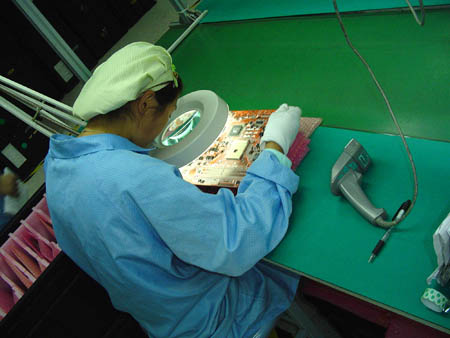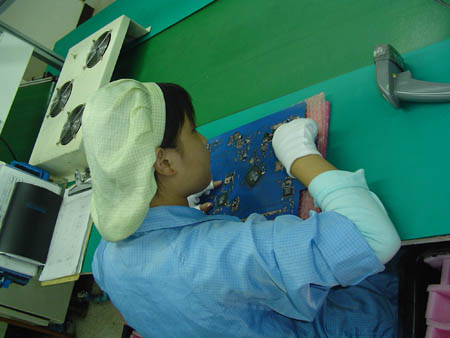The Birth of an Abit NF7 - A Factory Tour
by Kristopher Kubicki on June 11, 2004 10:12 PM EST- Posted in
- Motherboards
SMT QA
After the SMT process, we can see the transformation that the board has undergone. The north and south bridges are now present, along with thousands of ceramic capacitors and LEDs. This particular board is a K8V Pro, but we would see a very similar end result on the NF7. SMT lines run the same model and do not skip around; we shot this picture from a different line.Since SMT is the most complicated procedure when producing a motherboard, rigorous testing is done at this point. The boards must past visual inspection to assure no stray SMDs are printed, and then the boards are checked to make sure every SMD is lined up properly. A single offset capacitor can mean the difference between a working and non-working motherboard.
Because of the stringent quality control, the first visual inspection is done with an overlay to help a factory worker inspect the components. You can see this process below. The inspector in this image is looking specifically for misaligned components.
Manual visual inspection is starting to get too costly and inefficient for Abit's means. The important thing to consider about labor in China is that it is very cheap; manual labor is almost always preferred when possible. On some production lines, a $200,000 visual inspection machine replaces the job of two physical inspectors. The machine and a technician can do a more exhaustive examination of a motherboard at a slightly faster pace than 1 traditional visual inspector, but the cost benefit ratio is not very good. The machine technician and the traditional visual inspectors are paid about the same; usually around $100 per month with lodging.
Several attendees on the tour were surprised about the sheer amount of physical labor in a factory like Rolly. Rolly is actually quite small in comparison to some of the other factories that we have seen. It employs 1,400 workers and runs a single 8AM to 5PM shift. Even if it takes 10 workers to do the job of a single $200,000 machine, the cost of the machine usually outweighs the cost of using manual labor. Futuristic, all machine-run factories don't exist in China.
One thing that caught our attention at the Abit factory was the process of quality control. We recall the Elite Group factory tour from a year ago; when workers detected component failure or issues with a board after SMT, the board was completely pitched. At Rolly, we noticed that if a motherboard failed, it was immediately retested. Occasionally, these boards would fail continually, but after several tries, the components would usually pass inspection. Abit representatives explained to us that this procedure was because Rolly purposely sets inspection tolerances too tight and compensates for the extra manpower to test and retest (and retest again) by relying on its relatively cheap workforce.












19 Comments
View All Comments
fengpc - Sunday, August 22, 2004 - link
Visited Suzhou two times, it's a nicer area than ShenZhen IMO. The industry zones look cleaner and more organized. However I believe they will have power issues just like other mfg zones in China soon. Nice article, enjoy reading it.KristopherKubicki - Wednesday, June 16, 2004 - link
http://images.anandtech.com/reviews/motherboards/a...Kristopher
Glenngalata - Wednesday, June 16, 2004 - link
An excellent overview of what is involved in the motherboard manufacturing world.The key point to this article is the availability of cheap labor. There would never be a way to produce an American made motherboard product that would be cost effective against the the far east produced items which is unfortunate.
Another key point to the article is the comment of the ABIT quality control being obviously tighter than that of ECS. Anyone who has owned an ECS product can attest to the fact that the lemon rate for their products distinctly shows the quality difference going against ECS. They may be a larger company but they did not get there by catering to buyers who care about any level of satisfaction. Maybe this is why ECS was voted one of the worst quality control entities in the entire motherboard segment.
The choice is yours but ABIT scored my vote on this one.
MadAd - Wednesday, June 16, 2004 - link
yeah please, whats the url?KristopherKubicki - Tuesday, June 15, 2004 - link
14: I have it - its 23MB though. send me an email, i will drop it somewhere you can pick it up.Kristopher
manzana - Tuesday, June 15, 2004 - link
Interesting article. Wish there was a video of that person building the pc within 1 minute ;)araczynski - Monday, June 14, 2004 - link
very nice article, makes me miss my days in the industrial automation field, but not the pressures :)KristopherKubicki - Monday, June 14, 2004 - link
Jaramin,Like i said in the ECS article also, workers work about 8 to 9 hours a day and are provided with meals/housing. There is very little variation between any company that operates out of China; its kind of all about standardized. If you have any other specific political or economic questions feel free to ask.
Kristopher
Jaramin - Monday, June 14, 2004 - link
It would be nice if some more information about the ethical or human ressource aspect of the manufacture would be included. The only thing that was provided here is that the workers are paid 100$/month...Some of us like to know what is the actual human cost of a product. Knowing that company A offers better working conditions than B could certainly weight on my choice of boards.
ViRGE - Monday, June 14, 2004 - link
While I don't really have anything of substance to say, I would like to say that this is one of those "wow, that's cool" kind of articles that are always great to see. Kudos for doing these kinds of things, guys.